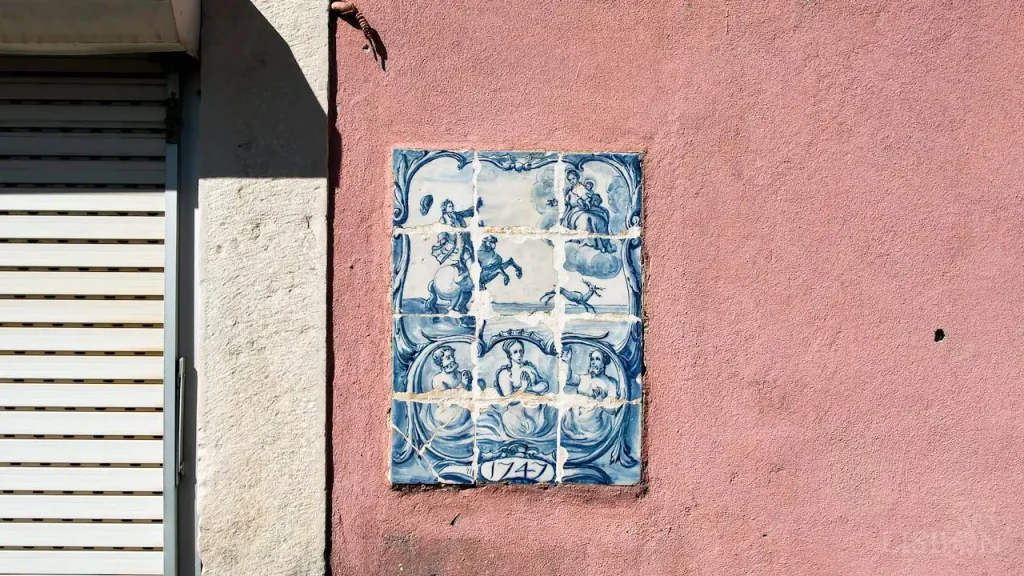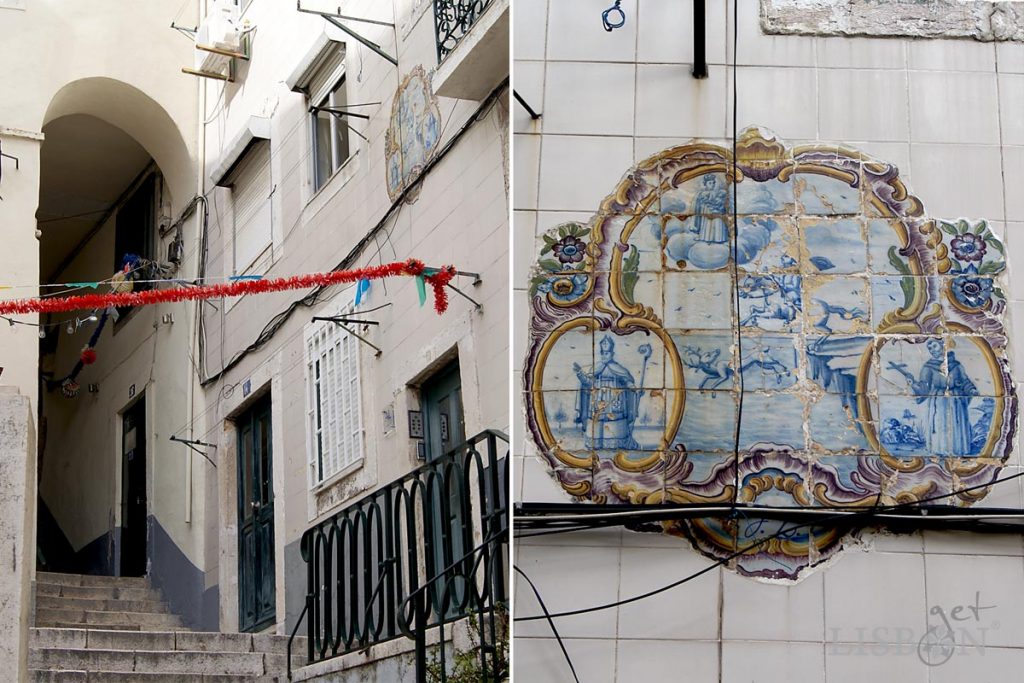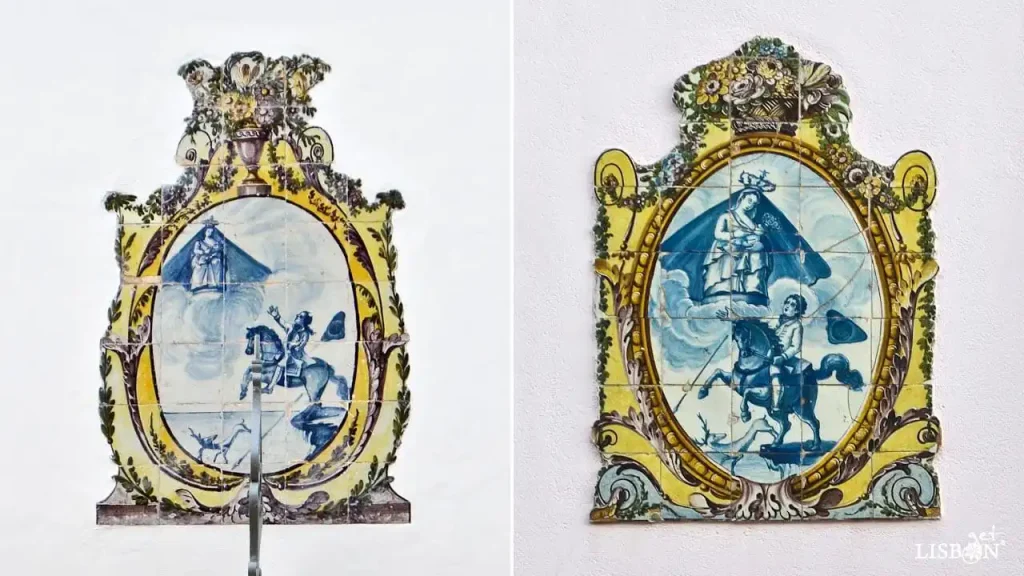Updated on 30 September 2025
Original article published on 13 February 2019
The iconography connected to Our Lady of Nazaré and to the Miracle of D. Fuas Roupinho is relatively common in the West region of the country, particularly in the area of Nazaré.
In Lisbon this theme is not so frequently represented, but during our walks through the City of Seven Hills we came across interesting evocations of this miracle that we wish to share with our readers.
Let’s, in the first place. find out about the story of Our Lady of Nazaré and the Miracle of D. Fuas Roupinho, one of the most famous legends of the history of Portugal.
Get to know Lisbon’s historic neighbourhoods in a guided tour and discover unmissable places of this magnificent city.
Our Lady of Nazaré and the Miracle of D. Fuas Roupinho
The first time the story of the origin of the image of Our Lady of Nazaré and the Miracle of D. Fuas Roupinho was told dates back to the late 16th century.
It was Friar Bernardo de Brito from the Alcobaça Monastery who told it. He was also the one who had the initiative to unblock the cave where supposedly the image of the Virgin was found in order to build the chapel that today exists in the Sítio da Nazaré (Place of the Nazaré).
According to the friar, the image of the Virgin was sculpted by St. Joseph himself in Nazareth in Palestine, hence the name Nazaré, and after countless vicissitudes, it was brought to the Iberian Peninsula and hidden in a cave where, in 12th century, D. Fuas Roupinho found it and started venerating it.
D. Fuas was a noble knight close to King Afonso Henriques, 1st Admiral of the Tagus Squadron, Alcalde of Porto de Mós and protagonist of this famous miracle. It is said that in a foggy day, while he chased a deer he was saved from falling from the promontory after evoking the Virgin. In order to show his gratefulness he donated this territory to Our Lady of Nazaré.
The diffusion of this cult went from being passed on orally to being written down, being always iconographically associated to the miracle of D. Fuas Roupinho. Since then that the pilgrims from everywhere and from every social strata started going to this territory and many miracles happened.
However, there is no coeval document that proves the existence of this knight and today it is known that the image of the Virgin is a product of a regional workshop of the 14th and 15th centuries. These facts confirm the legend and not the story, but either way its artistic manifestations are interesting.


The Evocations of Our Lady of Nazaré and the Miracle of D. Fuas Roupinho in Lisbon
We’re thus sharing with you some evocations in Lisbon of Our Lady of Nazaré and the Miracle of D. Fuas Roupinho that are present in very different both physical and time contexts.
Benfica: The Evocation in a Tilework Fragment

At number 6 on Rua Direita da Palma, in Benfica, there is a small tilework feature, composed of 3 by 4 tiles, which appears to have been part of a larger panel. Executed in blue and white, it features two sections: in the upper part, the traditional representation of the miracle in question, and below, within a field surrounded by acanthus leaves, three souls from purgatory appeal for the prayers of those who observe it. The date 1747 is also recorded there.
Alfama, the Evocation in a Tilework Panel

In Alfama, at Beco do Maquinez nº10, there is a Rococo-style tilework, dating from the third quarter of the 18th century, produced in the aftermath of the 1755 earthquake, like most of the tilework features found above doors and windows in the oldest neighborhoods of Lisbon. After the tragedy, these images of devotion and protection became widespread and common in buildings across all social strata.
The panel consists of a polychromatic frame (yellow, blue and green) constituted by shell and plant-inspired motifs. This complex frame involves three distinct scenes painted in white and blue.
On the bottom left side we can see Saint Martial, a bishop with his attributes (mitre, dalmatic and crozier) blessing the home and everyone who passes by. This saint is commonly represented in this popular context as a protector against fires and is thus the patron saint of the firefighters.
On the right side, Saint Francis of Assisi holds a cross and shows his stigmata. He’s the protector of animals, the representation of starkness, humility and hope.
Finally, in the centre is represented the apparition of Our Lady of Nazaré and the miracle of D. Fuas Roupinho. The Lady is crowned, standing and holding baby Jesus, surrounded by clouds. Further down we see D. Fuas riding a horse while chasing the deer in the exact moment when the horse miraculously stopped, preventing him from falling from the cliff.
The choice of this iconography indicates that the habitant or owner of this building has a connection to Nazaré, which is not surprising, since this building is located in the neighbourhood of Alfama, which was once a place of fishermen from different fishing areas of the country
Prazeres Cemetery, an Evocation in a Tomb

In order to find the third evocation that we propose to you, we have to head to the Prazeres Cemetery, in Campo de Ourique. Here, in the intersection of the street 3A and the street 26, we find the tomb no. 5687 of Cândido Rodrigues, built between 1915 and 1917, which displays a tile panel where Our Lady of Nazaré and the Miracle of D. Fuas Roupinho are represented.
The project doesn’t show a date nor descriptive document that allows us to know the intention of who ordered it. However, the choice of this type of iconography so specific and uncommon in the region of Lisbon certainly results from a devotion or a personal connection of the owner with Nazaré, a fact that is indicated in the documentation available in the archive we’ve consulted.
The panel, which is not signed nor has indication of the place of manufacture, has a reverse curved arch as a frame that finishes with a circled Cross Pattée, symbol of the ideal of spiritual cavalry and, for that reason, a symbol adopted by the Knights Templar.
If we associate to it the two corinthian columns that flank the tomb’s door, knowing that these symbolise beauty and the personification of the senior warden, we can extrapolate a relationship with the Freemasonry, but it could also just be a decorative choice.
This panel too presents a common pattern in the Portuguese tilework between the 2nd half of the 18th century and the 1st half of the 20th century, the representation of two times: the present, decorative and colourful and the historic or mythic past, in the white and blue scenes in a direct evocation of the tilework of the beginning of the 1700’s.
The naturalist representation indicates a more erudite artist than the one of Alfama, but the composition is identical.
Do not hesitate to pay a visit to this fantastic historical cemetery, there you will find a real open air museum with many other reasons of interest.
| Never miss another article | Subscribe here |
The Maritime Station of Alcântara, the Evocation in the Mural of Almada Negreiros

The last evocation of Our Lady of Nazaré and the Miracle of D. Fuas Roupinho that we bring to you is located in the Maritime Station of Alcântara in a mural of the plastic artist Almada Negreiros from the 1940’s.
The Maritime Station of Alcântara is a modernist building projected by the architect Porfírio Pardal Monteiro that is situated in the West zone of Lisbon.
Once the reception hall for those arriving in Lisbon by sea, today it houses, together with the Rocha do Conde de Óbidos Maritime Station, the Interpretative Centre Murals of Almada in the Maritime Stations.
We suggest reading the article Palace of the Counts of Óbidos, located on the hill known as Rocha Conde d’Óbidos.
Almada Negreiros’ paintings for the Gare Marítima de Alcântara consist of two triptychs that evoke the maritime and adventurous vocation of the Portuguese and the riverside life of Lisbon, and two isolated paintings where symbolic and traditional values are defended.
It’s in one of the latter ones that we find the representation of the Miracle of Nazaré, a traditional composition but that presents a few curious details.
D. Fuas Roupinho is dressed as a Portuguese bullfight horseman, which is connected to a Portuguese cultural tradition that was very enjoyed at the time.
Our Lady of Nazaré, in turn, is represented with the attributes of the Immaculate Conception, queen of Portugal, and in addition to being crowned and having Baby Jesus in her arms, she has by her feet the lunar crescent and the snake with the apple of the original sin.
On the bottom part of the mural are also represented the people of Nazaré wearing curious traditional clothes related to their tough jobs. This peculiar fishing village was one of the first to be promoted internationally, having its economy progressively shifted from mainly fishing to mainly tourism.
Our Readers’ Contributions

In response to our appeal to readers regarding the existence of other representations of this theme in Lisbon, we received word, thanks to our friends and collaborators Luís Bayó Veiga and Alexis Passechnikoff, and our reader Vítor Neves, of two further examples.
With similar characteristics, they are located in different areas of the city: the first at Rua Direita, 44, in Paço do Lumiar, and the other at Rua de Campo de Ourique, 161.
Both depict the scene in blue and white, with a polychrome frame of floral and plant motifs in a Rococo style, although probably produced at a later date.
We are grateful to our attentive readers whose observations and contributions have a positive impact on the development of our project!
The project getLISBON has been very rewarding and we want to continue revealing the singularities of fascinating Lisbon.
Help us keep this project alive!
By using these links to make your reservations you’ll be supporting us. With no extra costs!
• Looking for a different experience? We can create a customised itinerary based on your interests. Contact us!
• Or if you prefer tours and other activities in various destinations, take a look at GetYourGuide.
• Save time and money with a flexible Lisbon Card!




